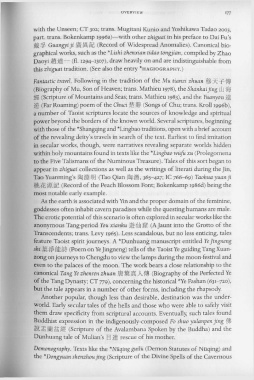Page 217 - The Encyclopedia of Taoism v1_A-L
P. 217
OVERVI EW 177
with the Unseen; CT 302; trans. Mugitaru Kunio and Yoshikawa Tadao 2003,
part. trans. Bokenkamp 1996a)-with other zhiguai in his preface to Dai Fu's
}!&2¥ Guangyi ji $I ~ ifc1. (Record of Widespread Anomalies). Canonical bio-
graphical works, such as the *Lishi zhenxian tidao tongjian, compiled by Zhao
Daoyi Mill! - (£1. 1294- 1307), draw heavily on and are indistinguishable from
this zhiguai tradition. (See also the entry *HAGIOGRAPHY.)
Fantastic travel. Following in the tradition of the Mu tianzi zhuan ~*Tfw
(Biography of Mu, Son of Heaven; trans. Mathieu 1978), the Shanhai jing LlJ rBJ
~~ (Scripture of Mountains and Seas; trans. Mathieu 1983), and the Yuanyou Ji
J!ii: (Far Roaming) poem of the Chuci ~ ~ (Songs of Chu; trans. Kroll 1996b),
a number of Taoist scriptures locate the sources of knowledge and spiritual
power beyond the borders of the known world. Several scriptures, beginning
with those of the *Shangqing and *Lingbao traditions, open with a brief account
of the revealing deity's travels in search of the text. Earliest to find imitation
in secular works, though, were narratives revealing separate worlds hidden
within holy mountains found in texts like the *Lingbao wufo. xu (Prolegomena
to the Five Talismans of the Numinous Treasure). Tales of this sort began to
appear in zhiguai collections as well as the writings of literati during the Jin,
Tao Yuanming' s ~ mM ~ (Tao Qian Jl*J:m, 365- 427; I C 766-69) Taohua yuan ji
t:J~ 1-t: ?m\~B (Record of the Peach Blossom Font; Bokenkamp 1986d) being the
most notable early example.
As the earth is associated with Yin and the proper domain of the feminine,
goddesses often inhabit cavern paradises while the questing humans are male.
The erotic potential of this scenario is often explored in secular works like the
anonymous Tang-period You xianku J!ii:fw g (AJaunt into the Grotto of the
Transcendents; trans. Levy 1965). Less scandalous, but no less enticing, tales
feature Taoist spirit journeys. A *Dunhuang manuscript entitled Ye Jingneng
shi ~ ~ ~~ ~ (Poem on Ye Jingneng) tells of the Taoist Ye guiding Tang Xuan-
zong on journeys to Chengdu to view the lamps during the moon-festival and
even to the palaces of the moon. The work bears a close relationship to the
canonical Tang Ye zhenren zhuan r.!f~1i;\.1$ (Biography of the Perfected Ye
of the Tang Dynasty; CT 779), concerning the historical *Ye Fashan (631- 720),
but the tale appears in a number of other forms, including the rhapsody.
Another popular, though less than desirable, destination was the under-
world. Early secular tales of the hells and those who were able to safely visit
them draw specificity from scriptural accounts. Eventually, such tales found
Buddhist expression in the indigenously-composed Fo shuo yulanpen jing f!i#
~ % mr ~U~ (Scripture of the Avalambana Spoken by the Buddha) and the
Dunhuang tale of Mulian's I§ it rescue of his mother.
Demonography. Texts like the *Nii.qing guilii. (Demon Statutes of Niiqing) and
the *Dongyuan shenzhou jing (Scripture of the Divine Spells of the Cavernous

